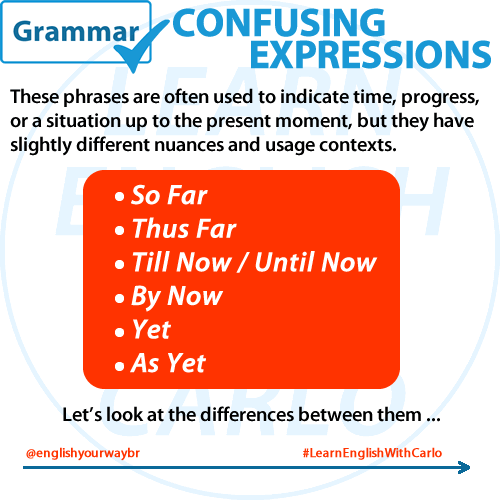So far, thus far, till now, until now, by now, yet, as yet

These phrases are often used to indicate time, progress, or a situation up to the present moment, but they have slightly different nuances and usage contexts.
1. So Far
- Meaning: Up to this point in time.
- Usage: Commonly used to talk about progress or results. It suggests that the situation may continue.
- Example: “So far, we’ve raised $500 for charity.”
2. Thus Far
- Meaning: Similar to “so far,” but slightly more formal or literary.
- Usage: Used in a more formal context, but it also indicates progress up to the present moment.
- Example: “Thus far, the project has been a success.”
3. Till Now / Until Now
- Meaning: Up to the present moment, often implying that a change has occurred or is about to occur.
- Usage: Can suggest a contrast between the past and present.
- Example: “Until now, I had never considered a career in teaching.”
4. By Now
- Meaning: Refers to a point in time that has passed, indicating that something should have happened or been completed.
- Usage: Often used when there is an expectation of completion.
- Example: “By now, you should have received the package.”
5. Yet
- Meaning: Used to describe something that hasn’t happened by a certain time, but is expected to happen.
- Usage: Often used in questions and negative sentences.
- Example: “I haven’t finished the report yet.”
6. As Yet
- Meaning: Similar to “yet,” but slightly more formal.
- Usage: Often used in negative contexts to indicate something hasn’t happened up to the current moment.
- Example: “As yet, no one has claimed the lost item.”
Summary:
- So Far / Thus Far: Progress or situation up to now, with potential to continue.
- Till Now / Until Now: Situation up to the present, often implying change.
- By Now: Expectation of something having happened by this time.
- Yet / As Yet: Indicates something expected has not happened yet.
Each phrase has its context, with some being more formal or implying expectation or change.
